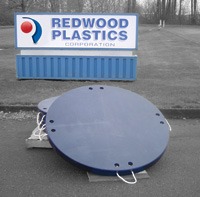When customers consider a switch to plastic outrigger pads they sometimes don’t know where to start in how to get their quotation. Often we’ll be told that the customer has a certain piece of equipment and to spec a pad size and thickness for them but this over-complicates things a little. Regarding the size of the pad the simplest way is to just get the plastic pads with the same dimensions as the stock pads that came with your rig. If you don’t have your stock pads we can help you out but we do need to know the area of your outrigger feet (length x width and are the feet square or round?).
Thickness is a little trickier to specify. UHMW plastic, commonly used for outrigger pads, is virtually unbreakable but having a pad that is too small and thin may lead it to bend around the outrigger foot as it is more flexible than wood and this may destabilize the rig. A general rule of thumb for most vehicles in the 20-50 ton range is to go with 1.5″ thick pads. 2″ thick is usually good for 50-70 ton but using 2″ pads for lighter equipment will result in less flex with the pad and a more stable lift. Above 70 ton 3″ thick pads are strongly recommended. To reiterate: the plastic will most likely not break on a thinner pad; however, the amount of flex may be undesirable. This is partially dependent on where the pads are being used – we have certain customers who only ever lift on concrete surfaces and thus can use a thinner pad because it has more support. Customers who lift on soggy soils may need thicker pads. As always, we refer to OSHA in that lifts should only ever be done on stable, level, ground.
For questions about our Redco Outrigger pads or to get some pricing please contact us for a quote.

